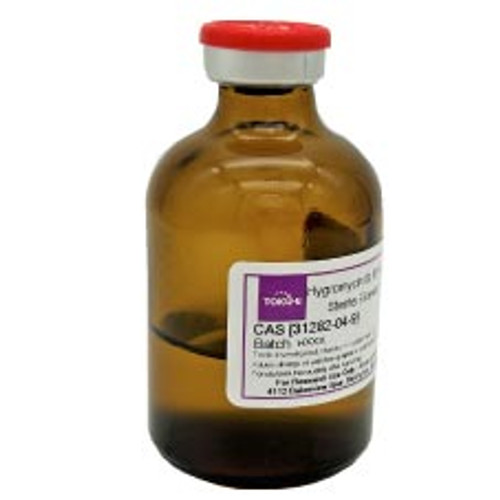Tetracycline ReadyMadeTM Solution is provided as a sterile-filtered solution of Tetracycline Hydrochloride (Tetracycline HCl) formulated in water at a concntration of 10 mg/ml. It has been filter-sterilized using a 0.22 μm filter.
Tetracycline is a bacteriostatic polyketide antibiotic used in a wide range of in vitro cell culture applications.
Tetracycline was identified in 1953 by Lloyd Conover (Pfizer) in collaboration with RB Woodward (Harvard University). It is a naturally occurring antibiotic from Streptomyces sp. (S. aureofaciens, S. rimosus, S. viridofacien) that shows wide-ranging activity against both Gram-negative and Gram-positive bacteria.
| Mechanism of Action | Tetracycline inhibits bacterial growth in Gram-positive and Gram-negative bacteria by disrupting codon-anticodon interactions at the ribosome, thus blocking protein synthesis. Specifically, Tetracycline binds to a single site on the 30S ribosomal subunit and inhibit protein synthesis by blocking the attachment of charged aminoacyl-tRNA to the A site on the ribosome. Thus, they prevent introduction of new amino acids to the nascent peptide chain. |
| Spectrum |
Tetracycline is a broad-spectrum antibiotic, effective against both Gram-positive, Gram-negative bacteria, and mycoplasma. A few species of bacteria display intrinsic resistance to tetracycline, including Pseudomonas aeruginosa. Acquired resistance has proliferated in many pathogenic organisms and greatly eroded the versatility of Tetracycline derivatives. Resistance among Staphylococcus, Streptococcus, Neisseria gonorrhoeae, and members of the Enterobacteriaceae is now quite common. The spectrum of Tetracycline activity encompasses various protozoa such as P. falciparum, Entamoeba histolytica, Giardia lamblia, Leishmania major, Trichomonas vaginalis, and Toxoplasma gondii. |
| Microbiology Applications |
Tetracycline is routinely used as a selective agent to select for bacterial cells that have been transformed with a plasmid containing the Tetracycline resistance gene, tet. Tetracycline is typically used at 10 µg/mL. Tetracycline has activity against the bacteria causing: Q fever, Rocky Mountain spotted fever, tick fevers, typhus fever, and Brill-Zinsser disease. It is also used to to treat upper respiratory infections and acne. It has been used in studies of multidrug resistance and potential side effects including acute pancreatitis. |
| Plant Biology Applications | Tetracycline has been shown to suppress symptoms of aster yellows disease in China Aster and Chrysanthemum. Tetracyclines are sprayed onto fruit trees and other plants to treat infection by Erwinia amylovora, injected into palm trees to treat mycoplasma infections (lethal yellow), and used to control infection of seeds by Xanthomonas campestris (black rot). Multiple applications of Tetracycline resulted in symptomless axillary plant growth (Davis and Whitcomb, 1970). |
| Eukaryotic Cell Culture Applications |
There are several popular systems including Tet-off, Tet-on and Tet autoregulatory systems which help to minimize leaky background in uninduced cells. When using the Tet system in mammalian cell culture, it is important to either use animal-free media or to test each batch of fetal bovine serum (FBS) to confirm that contaminating tetracyclines are absent or are too low to interfere with induction. Doxycycline (Dox) is a water-soluble tetracycline derivative that is preferred for almost all Tet-controlled gene expression systems. Standard concentration in cell culture is 1 mg/L, but may vary according to your system. For additional information, please visit our cell-culture database. |
| Cancer Applications |
Tetracycline derivatives induce apoptosis in osteoclasts, Jurkat T lymphocyte cells and in cultured monocytes and macrophages. Tetracycline and chemically modified tetracyclines, like Col-3, inhibit the activity of several matrix metalloproteinases (MMPs) that are important enzymes in tumor cell invasion and metastatic ability. |
| Molecular Formula | C22H24N2O8 • HCl |
| References |
Backman K, Boyer HW (1983) Tetracycline resistance in Esherichia coli is mediated by one polypeptide. Gene 26(2-3): 197-203 PMID 6323260 Chopra I and Roberts M (2001) Tetracycline antibiotics: Mode of action, applications, molecular biology, and epidemiology of bacterial resistance. Microbiol. Molec. Biol. Rev. 65(2):232-60 PMID 11381101 Davis RE and Whitcomb RF (1970) Evidence on possible Mycoplasma etiology of Aster Yellows disease. Infect. Immun. Infect. Immun. 2(2):201-208 PMID 16557820 Gatz C (1995) Novel inducible/repressible gene expression systems. Methods Cell Biol. 50: 411-424 PMID 8531813 Green M and Sambrook J. Molecular Cloning: A laboratory manual 4th ed. Vol II, Cold Spring Harbor Laboratory Press, New York |








